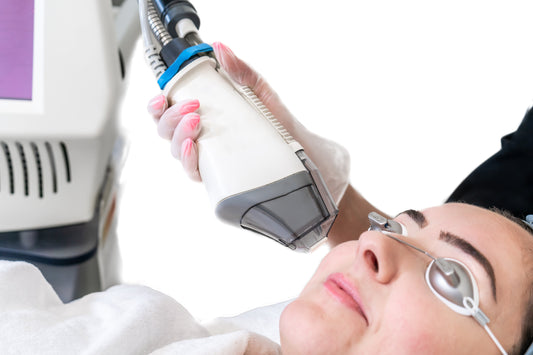When I was a teenager, tanning beds were the norm, “sunscreen” was simply not discussed, and wearing a hat outside would likely have ruined the Sun In copiously sprayed in our hair. Cut to twenty years later, and suddenly, my face and chest are covered in brown spots.
Hyperpigmentation.
Hyperpigmentation can sneak up on you in this way, often after years of sun worshiping, but it can also have other underlying causes. In this article, we’ll discuss what causes hyperpigmentation, the different types, how you can tell if you have it, how to treat it, and how to prevent it in the first place.
What Causes Hyperpigmentation?
Hyperpigmentation is a condition which causes some parts of the skin to appear darker than others.1 These spots typically look brown, but can also appear black, red, gray, or pink, and can show up in just one part of the body, or all over.
The underlying reason for hyperpigmentation is something called “melanin,” which is made by our skin cells. Melanin is what gives the skin its color; when skin cells are damaged or unhealthy, they can start to produce too much melanin. It “clumps up,” which causes that area to appear darker.1
According to Cleveland Clinic, this over-production of melanin can be caused by several things1:
- Adrenal disorders: These can cause the body to produce too little cortisol, which can lead to hyperpigmentation.
- Genetics: If hyperpigmentation or freckles run in your family, you’re more likely to have them.
- Hormonal changes: Pregnancy and puberty are common causes of hormonal hyperpigmentation.
- Injury to the skin: Acne scars, cuts, or burns can cause what is called “post inflammatory hyperpigmentation”.
- Medications: Things like oral contraceptives can cause hormonal fluctuations, and certain acne medications can make you more sensitive to sunlight, both of which can lead to hyperpigmentation.
- Melasma: Melasma is a skin condition that commonly affects women, causing patches of hyperpigmentation. These are often symmetrical and usually appear on the forehead, cheeks, or cheekbones.2
- Not getting enough of certain vitamins: A lack of certain vitamins can lead to hyperpigmentation.
- Sun damage: Sun damage is one of the most common causes of hyperpigmentation. These spots are often called “solar lentigines.”
- Thyroid disorders: Having an overactive thyroid (hyperthyroidism) may lead to hyperpigmentation through increased capillary fragility.3
Night Renewal Cream
• Anti-aging defense, moisturizer
• Improves fine lines, skin texture
Different Types of Hyperpigmentation
According to Harvard Medical School, these are the most common types of hyperpigmentation4:
- Freckles: These small tan or brown spots usually develop in childhood from sun exposure. They become darker and more numerous with time spent in the sun and heat and tend to fade a bit in the winter.
- Age spots: Also called “solar lentigines,” age spots are larger than freckles and tend to develop in adulthood on the face, forearms, chest, and hands.
- Melasma: These irregular dark patches on the face are usually due to hormonal fluctuations and / or sun exposure, so mostly occur in females in their 20s and 30s.
- Maturational hyperpigmentation: People with darker skin tend to experience this on the sides of their face due to sun exposure or underlying metabolic disease.
- Periorbital hyperpigmentation: Also referred to as dark circles, this is skin darkening that occurs around the eyes.
- Acanthosis nigricans: This is a darkening of the skin in areas that rub together, like the armpits, back of the neck, or groin.
- Post-inflammatory hyperpigmentation: This sort of hyperpigmentation occurs after injury to the skin, for example, from burns, acne, wounds, or rashes.
Identifying Signs & Symptoms
The only symptoms associated with hyperpigmentation are dark spots. If you have spots on your skin that are also causing other symptoms (like burning, oozing, itching, etc.) this may be something other than hyperpigmentation and you should speak to your dermatologist.1
Effective Topical Treatment Options
Okay, here’s the good news: hyperpigmentation can be treated (over time), and the most common and effective treatments are easily available topical treatments. Foundation Skincare has several products that can help:
- Azelaic Acid 14% Cream: Azelaic acid has been proven to effectively reduce hyperpigmentation disorders like melasma and post-inflammatory hyperpigmentation.5 Foundation’s 14% cream is available over-the-counter and is nearly as strong as prescription strength cream (15% percent.)
- Vitamin C Lotion 20%: Vitamin C can be used topically as a cream or taken orally. Topically, vitamin C creams have been shown to reduce pigmentation over time.6 Additionally, vitamin C has the benefit of reducing wrinkles caused by sun damage, by increasing collagen production.6 Our 20% lotion is highly potent and can be used twice a day because it is in a lotion form that is also very hydrating.
- Niacinamide Lotion 10%: Studies show that using this B vitamin topically significantly decreases hyperpigmentation and increases skin lightness.7 Foundation’s 10% formula can also reduce inflammation and prevent acne from occuring, which may prevent future pigmentation spots from forming.
- Night Renewal Cream: Retinoids have been proven over and over to reduce everything from hyperpigmentation to wrinkles.8 The Night Renewal Cream includes 2% Granactive Retinoid to rejuvenate skin with less irritation, as well as peptide growth factors to increase collagen and elastin.
In addition to topical products, we recommend taking these oral supplements strategically formulated by our very own dermatologist Dr. Tony Nuara, MD PhD, a pharmacist and a chemist, to really get at the hyperpigmentation issue from all sides:
- Pigmentation Defense: With ingredients like ascorbic acid, vitamin E, and ginkgo biloba, this daily supplement can help balance melanin production, while supporting skin cells and repairing damaged tissues.
- Spectrum: Spectrum combines plant-based antioxidants like Polypodium Leucotomos (PL) extract and key vitamins like nicotinamide to fade hyperpigmentation and promote overall skin health. The supplement also protects against environmental stressors and supports skin renewal.
Professional Treatment Options
Certain professional treatments can be used to either “kick off” your pigmentation correction journey, or after trying other, gentler, topical measures. These are all non-surgical, non-invasive procedures you can get at the dermatologist's office.
- Laser treatments: Laser treatments work by either removing the top layer of skin (ablative lasers) or by simply targeting the dermis to promote collagen production (non-ablative.)9
- Light therapy: Light therapy is a non-invasive laser treatment that promotes collagen production and the skin’s natural ability to heal. This can reduce hyperpigmentation, especially in people with lighter skin.10
- Chemical peels: A chemical peel will remove the top layer of skin, which should encourage cellular turnover. Research points to the “phytic peel” as safe and effective for treating hyperpigmentation, especially for darker-skinned patients.11
- Microdermabrasion: Here, a drill-like tool will be swiped across the skin to remove the top layers of skin, including any superficial spots or scars.12
How to Prevent Hyperpigmentation
One of the most effective ways to prevent hyperpigmentation from forming in the first place is to practice safe sun habits. This means:
- Wear a broad spectrum sunscreen with an SPF of at least 30 and reapply often
- Wear a hat and sun-protective clothing when you’re outdoors
- Avoid direct sunlight for prolonged periods of time
Additionally, you can prevent hyperpigmentation by:
- Discontinuing any medications that may be causing it (hormonal birth control, acne medications, etc.)
- Avoiding skin bleaching products, which may cause hyperpigmentation
- Regularly moisturizing your skin to keep your skin barrier intact
- Avoiding picking at blemishes or insect bites
- Making sure you’re getting adequate vitamins through foods and / or supplements
If you’re like me, you may have spent some important years of your life worshiping the sun and it’s now catching up with you. The good news is, hyperpigmentation can be treated over time with various products, treatments, supplements, and let’s not forget, patience.
For me, I’ve been using retinoids, a good sunscreen, azelaic acid, niacinamide, and vitamin C every day for the past several years, and my hyperpigmentation is barely noticeable. So if you’re struggling with sun spots or melasma, don’t panic; you just need the right products and consistency!
Find more tips and resources on maintaining healthy hair and skin in the FS Blog.
References:
-
https://my.clevelandclinic.org/health/diseases/21885-hyperpigmentation
-
https://www.aad.org/public/diseases/a-z/melasma-overview
-
https://www.ncbi.nlm.nih.gov/pmc/articles/PMC6310574/
-
https://www.health.harvard.edu/diseases-and-conditions/demystifying-hyperpigmentation-causes-types-and-effective-treatments
-
https://pubmed.ncbi.nlm.nih.gov/38282869/
-
https://www.ncbi.nlm.nih.gov/pmc/articles/PMC7802860/
-
https://pubmed.ncbi.nlm.nih.gov/12100180/
-
https://www.ncbi.nlm.nih.gov/pmc/articles/PMC2699641/
-
https://www.mayoclinic.org/tests-procedures/laser-resurfacing/about/pac-20385114
-
https://www.ncbi.nlm.nih.gov/pmc/articles/PMC5418955/
-
https://www.ncbi.nlm.nih.gov/pmc/articles/PMC3560164/
-
https://www.ncbi.nlm.nih.gov/books/NBK535383/





